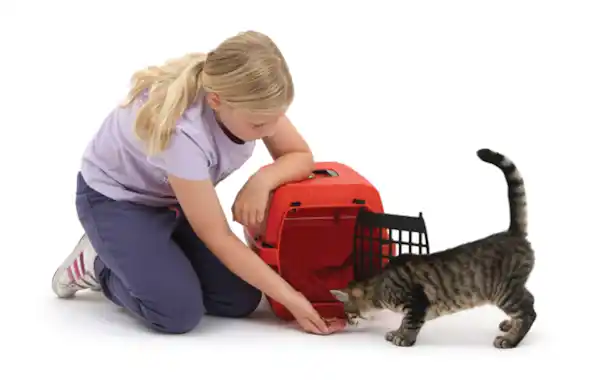Sarah and Chirag explain how you can teach your cat to stay in a carrier for travel - and even enjoy it!
In the first part of our cat carrier training, we discovered how you can teach your cat to settle on a mat and then use this 'skill' to help your cat voluntarily enter his carrier. Now we'll teach you how you can progress this so that your cat can remain in the carrier for longer periods of time and be transported in a relaxed and contented manner.
Having a cat happy to travel will make trips to places such as the cattery and vets so much easier as your cat will not arrive distressed and anxious from the journey. In order to progress with the steps described below, you need to have put into practice what we've been teaching?in our previous articles.
Your cat should now be happily moving into the carrier and settling on his mat inside it. The ideal way to get your cat to do this is by placing rewards (in this case, food treats are easiest) into the carrier from the slots at the rear. If your carrier has no slots towards the back, you can sometimes add these yourself.
Rewarding from this part of the carrier will encourage your cat to go all the way into the carrier and stay there. This is better than a hand coming in from the front to deliver treats as it could be perceived by the cat that you are blocking his exit.
Your goal is to teach your cat that it pays to remain in the carrier of his own choice. This might be because every few seconds he remains in there you deposit a tasty treat for him, which stops the moment he chooses to exit. It's essential he can exit freely whenever he wishes - and we suggest you keep the sessions short enough that you encourage him out before he leaves himself.
Leave him thinking he wants to go back in rather than he has had enough. This could even be the new way for your cat to be fed - a little dish of his food could be placed in the carrier.
Closing the carrier door
Once your cat is comfortable and is spending three to five minutes in the carrier, it is time to start teaching him that closing the door is ok. To teach this, start off as you have been and once your cat is in the carrier, reinforce (reward) him with a treat, close the door very slightly, and then reinforce again.
Shut the door further and further each time, being sure to open it straight away until you are fully closing it. You should open the door right away if your cat moves towards the door at any point, teaching him that he can control the door opening just by moving towards it if he wants to. This will hopefully build his confidence and show him he has no reason to panic. Again you must build this up so that your cat is comfortable being in there for around three to five minutes with the door closed before moving to the next stage.
It is important to ensure your cat can cope with being in the carrier in a relaxed manner for the length of time your longest journey is. For example, if your vet trip is usually half an hour, see if your cat gets to the stage where he remains in the carrier for this length of time of his own accord (door open) and build up to similar lengths of time with the door shut.

Moving the carrier
Now you are ready to add in the feeling of the carrier being lifted and moved. This can be difficult for your cat, so work in small steps. Repeat the steps above, and once the door is closed start to practise moving the carrier along the floor slowly without lifting it.
Remember, take it one step at a time and make the steps small increments of your final goal. Remember to reinforce your cat for staying in the carrier with rewards such as food treats placed in through the side or door of the carrier and soothing words. If he asks to leave the carrier at any time by miaowing or pawing the door, then immediately open the door and allow him to exit. If this does occur, your steps are probably too big and you need to work at a slower pace.
Once you are able to move the carrier on the floor, place your hand on the handle, let go straight away then reinforce your cat. Repeat this but now apply a little upwards lift as you would if you were going to pick up the carrier, then stop and reinforce your cat. Progress to being able to lift the carrier and put it back down. Make sure both the lifting and setting down of the carrier is gentle and steady as going into a box and being moved about is not normal for a cat and they often don't like to feel their feet 'off the ground'.
Many carriers have handles that, when lifted, make the carrier quite wobbly and unsteady for your cat inside. We recommend, where possible, to carry the carrier with both hands to stabilise it. Over time, don't just save carrier training for vet visits - make it part of your regular routine, practising at least once a week.
Teach your cat that getting in the carrier and being moved are associated with fun and pleasant activities, such as being taken to the kitchen where there may be an extra tasty treat waiting for him, or being taken to another room where you have his favourite toy ready for a game. If your cat is allowed outside, you could even use the carrier to take him to the garden. It is important for all cats that they get used to being in a carrier in the outside environment from house to car as well.
When you are ready to let your cat out of the carrier, open the door calmly and quietly. Try not to make too much of a fuss of him because we want all the rewards to be when he is in the carrier.
Travelling in the car
Once your cat is comfortable with being moved in the carrier, you need to get your cat used to travelling in the car if this is the mode of transport you use. Usually owners only take cats into cars for a trip to the vets. This can be associated with a stressful and unpleasant experience so be sure to teach the following in very small steps. Start by taking the carrier (with your cat inside) to the car, secure it and then remove the carrier, take it back inside, then allow your cat out.
Provide lots of tasty treats while the carrier is in the car and less attention when your cat is let back out, as you need to teach him that a carrier is a place where nice things happen so he creates positive associations. Repeat this over short but frequent training sessions. Progress in this manner so that you are able to shut the car doors, settle yourself, start the engine and drive a short way down the road. Gradually increase the journey to teach your cat to be comfortable travelling for enough time so that he is trained for the average journey you may need to undertake with him.
Remember to reassure and reward your cat at every stage so that he remains at ease in the carrier. By spending this time with your cat, not only will it enhance your relationship, but it will make travelling your cat in the carrier less stressful for both of you.








